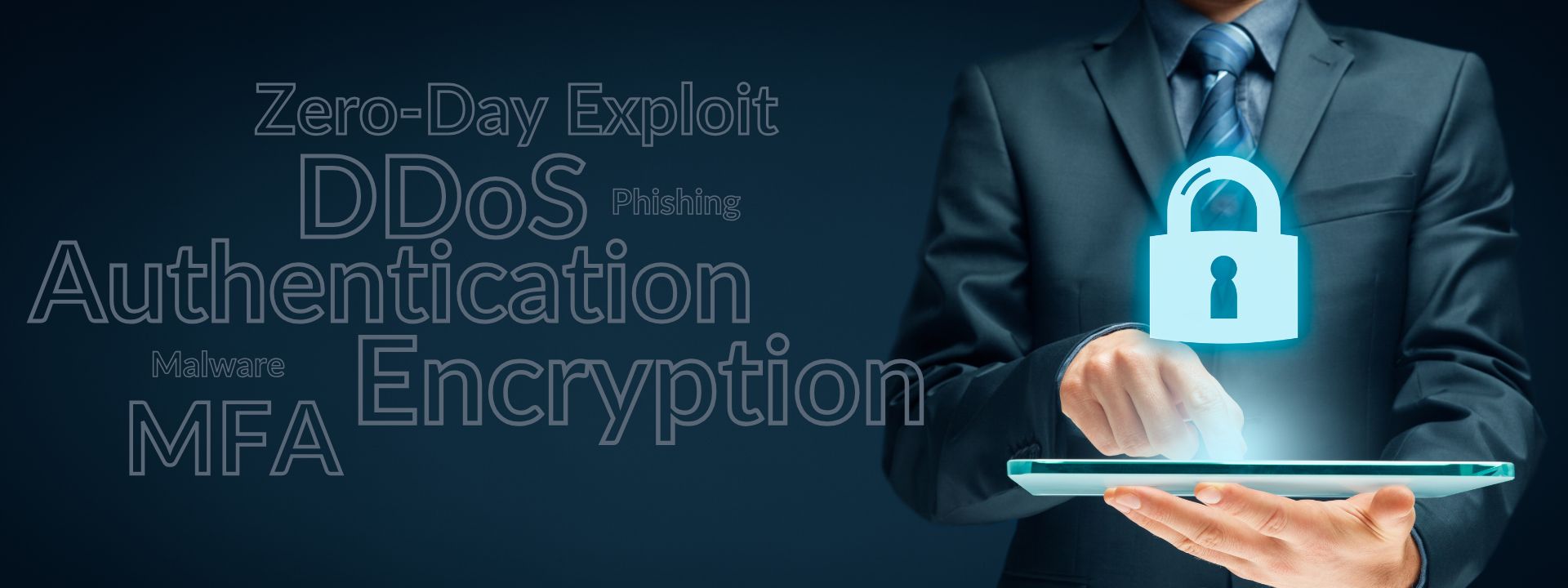The top 10 cybersecurity terms every professional and user must know are Malware, Phishing, Encryption, Firewall, Authentication, Authorization, Data Breach, DDoS Attack, Zero-Day Exploit, and Threat Intelligence. These concepts collectively define the digital threat landscape, the core defensive mechanisms, and the strategic actions organizations employ to protect critical information assets. Understanding these terms helps individuals and businesses actively mitigate risks, secure digital identity, and enforce the foundational security model known as the CIA Triad: Confidentiality, Integrity, and Availability.
The Foundation: Essential Concepts for Digital Defense
A strong security posture begins with understanding core principles that protect all information assets.
1. Authentication & Authorization (The Digital Gatekeepers)
Authentication verifies a user’s claimed identity. The system requires evidence proving a user is who they say they are. Users present credentials, such as a password or a fingerprint, to complete this crucial initial step.
Authorization determines what an authenticated user may access or do within the system. The system assigns specific permissions, ensuring users only view data necessary for their role. Separating these two processes enforces the Principle of Least Privilege, limiting potential damage.
The Power of Layers: Multi-Factor Authentication (MFA)
MFA significantly strengthens authentication by requiring multiple verification methods. It forces a user to provide evidence from two or more distinct categories. These categories include something you know (a password), something you have (a phone/token), and something you are (a biometric scan). Implementing MFA immediately frustrates credential theft attempts.
2. Encryption (The Shield of Secrecy)
Encryption converts readable data, or plaintext, into an unreadable scrambled format called ciphertext. This process secures information both during transmission and while stored (data in transit and data at rest). Only authorized parties possessing the correct decryption key can reverse the scrambling. Encryption is a primary tool for achieving confidentiality.
Mechanisms of Trust: Symmetric vs. Asymmetric Keys
Symmetric encryption uses a single key for both encryption and decryption. This method is fast but requires a secure mechanism for sharing the secret key. Asymmetric encryption, or Public Key Infrastructure (PKI), uses a mathematically linked public key and a private key. Anyone can encrypt data using the public key, but only the holder of the corresponding private key can decrypt it, providing superior security for key exchange.
High-Impact Threats: Understanding the Adversary’s Toolkit
Effective defense demands comprehensive knowledge of the common threats that actors deploy.
3. Malware (The Malicious Software Ecosystem)
Malware is a broad term describing any software specifically designed to damage, disable, or gain unauthorized access to a computer system. Attackers constantly develop new strains targeting systems and users globally. Malware represents the fundamental tool for most digital attacks, executing specific malicious actions. The advent of AI-driven malware makes these types of attacks even more prevalent.
A Family of Threats: Ransomware, Trojans, and Worms
Ransomware is a type of malware that specifically encrypts a victim’s files or locks their system. The attacker demands a ransom payment, typically in cryptocurrency, to restore access. Trojan horses, or Trojans, disguise themselves as legitimate software to trick users into installation; unlike viruses, they do not self-replicate. Worms are self-propagating malware; they exploit network vulnerabilities to spread autonomously from one system to another without requiring user interaction.
4. Phishing (The Art of Digital Deception)
Phishing employs deceptive electronic communications to fraudulently acquire sensitive information like usernames, passwords, and credit card details. Attackers craft messages, often impersonating a trustworthy entity, urging recipients to click a malicious link or open an infected attachment. Phishing relies on social engineering, exploiting human psychology rather than technical flaws.
Targeted Attacks: Spear Phishing and Whaling
Spear phishing is a highly targeted form of phishing, focusing on a specific individual or organization. The message uses personalized, credible details to increase the victim’s trust and likelihood of compliance. Whaling is an even more specialized spear phishing attack, targeting high-profile senior executives, such as CEOs or CFOs.
5. Zero-Day Exploit (The Unseen Vulnerability)
A Zero-Day Exploit uses a software vulnerability unknown to the software vendor or developer. The term “zero-day” means the vendor has had zero days to develop and release a patch. Attackers actively exploit this flaw before a patch becomes available, granting them a significant, dangerous window of opportunity. Organizations must prioritize continuous monitoring and layered defenses to combat these attacks.
6. Distributed Denial of Service (DDoS) Attack (Overwhelming the Target)
A DDoS Attack attempts to overwhelm a website, server, or network resource with a flood of malicious traffic. The sheer volume of traffic prevents legitimate users from accessing the system, effectively denying service. Attackers often use a Botnet, a network of compromised machines, to launch these attacks simultaneously, multiplying the attack’s strength.
Critical Infrastructure & Strategic Terms
Robust defense requires implementing critical structural components and adopting proactive strategies.
7. Firewall (The Network Border Control)
A Firewall establishes a security barrier between a trusted internal network and untrusted external networks, such as the public internet. This system analyzes network traffic based on predefined security rules. The firewall either permits or denies traffic, blocking unauthorized access and defending the network perimeter.
8. Virtual Private Network (VPN) (Securing the Connection Tunnel)
A VPN creates a secure, encrypted connection, or tunnel, over a less secure network, like the internet. It masks a user’s IP address and encrypts all data transmitted through the tunnel. VPNs ensure confidentiality and integrity, securing communication between remote users and the corporate network.
9. Data Breach (The Ultimate Security Failure)
A Data Breach occurs when an unauthorized party successfully accesses sensitive, protected, or confidential data. This represents the ultimate failure of security controls, often resulting in significant financial, legal, and reputational damage. The breach event itself is the successful exploitation of an existing vulnerability.
The Guiding Principle: Confidentiality, Integrity, and Availability (CIA Triad)
The CIA Triad represents the three core goals of information security management. Confidentiality ensures that only authorized users have access to data. Integrity guarantees the data remains accurate and unaltered by unauthorized parties. Availability confirms that authorized users can reliably access the systems and data when required. Security professionals use the CIA Triad as a fundamental checklist for assessing risks.
10. Threat Intelligence (Predicting Future Attacks)
Threat Intelligence refers to the analysis and refinement of information about current or potential digital attacks targeting an organization. Security teams collect raw data, process it, and convert it into actionable insights. Using this intelligence allows organizations to adopt a proactive security posture, anticipating and mitigating threats before they materialize.
The Future of Defense: Cybersecurity and AI
Artificial Intelligence (AI) and Machine Learning (ML) now actively shape defensive and offensive cybersecurity and AI strategies. Security teams use ML algorithms to analyze massive volumes of network data, identifying anomalous patterns indicative of sophisticated threats. AI automates the detection and response to attacks, fundamentally changing incident management workflows. Adversaries, conversely, use AI to craft highly realistic phishing campaigns and discover new Zero-Day vulnerabilities faster than human teams.
FAQs: Rapid Answers to Your Top Cybersecurity Questions
What is the single most important cybersecurity term?
Authentication is arguably the most critical term; without a verified identity, all subsequent security measures fail immediately.
How does the concept of “Zero Trust” secure a modern network?
Zero Trust mandates that no user or device, whether inside or outside the network perimeter, should be implicitly trusted. This framework enforces continuous verification and the Principle of Least Privilege for every access request, significantly limiting an attacker’s ability to move laterally across the network during a breach.
What is the difference between a vulnerability and an exploit?
A vulnerability is a weakness or flaw in a system or software component, representing a potential gap in security. An exploit is the actual code or set of commands that attackers use to take advantage of that specific vulnerability, actively performing a malicious action.
Protect Your Business With Windes
Get help from cyber threats by working with the Windes Tech and Risk Team. We can perform a cybersecurity check to assess your IT network for vulnerabilities that compromise the safety of client, customer, and business data.
Windes offers a comprehensive menu of risk management and cybersecurity essential services for companies in Long Beach, Orange County, Los Angeles, and beyond, ensuring your business is prepared and protected from cyber threats. Reach out to our Tech and Risk Team today to develop a robust cybersecurity strategy.

Randy Tanaka, CISSP, EnCE
Audit & Assurance Partner
Technology & Risk Practice Leader
Randy specializes in risk assessments, change management controls, ERP implementations, and their associated process flows. He identifies and develops scalable process improvement procedures to improve enterprise and operational risk management and fortify risk controls. With more than two decades of leadership and execution experience in both mid-tier and Big Four audit and consulting firms, Randy has collaborated with a diverse clientele, from small, privately-owned companies to Fortune 50 multinational corporations.



